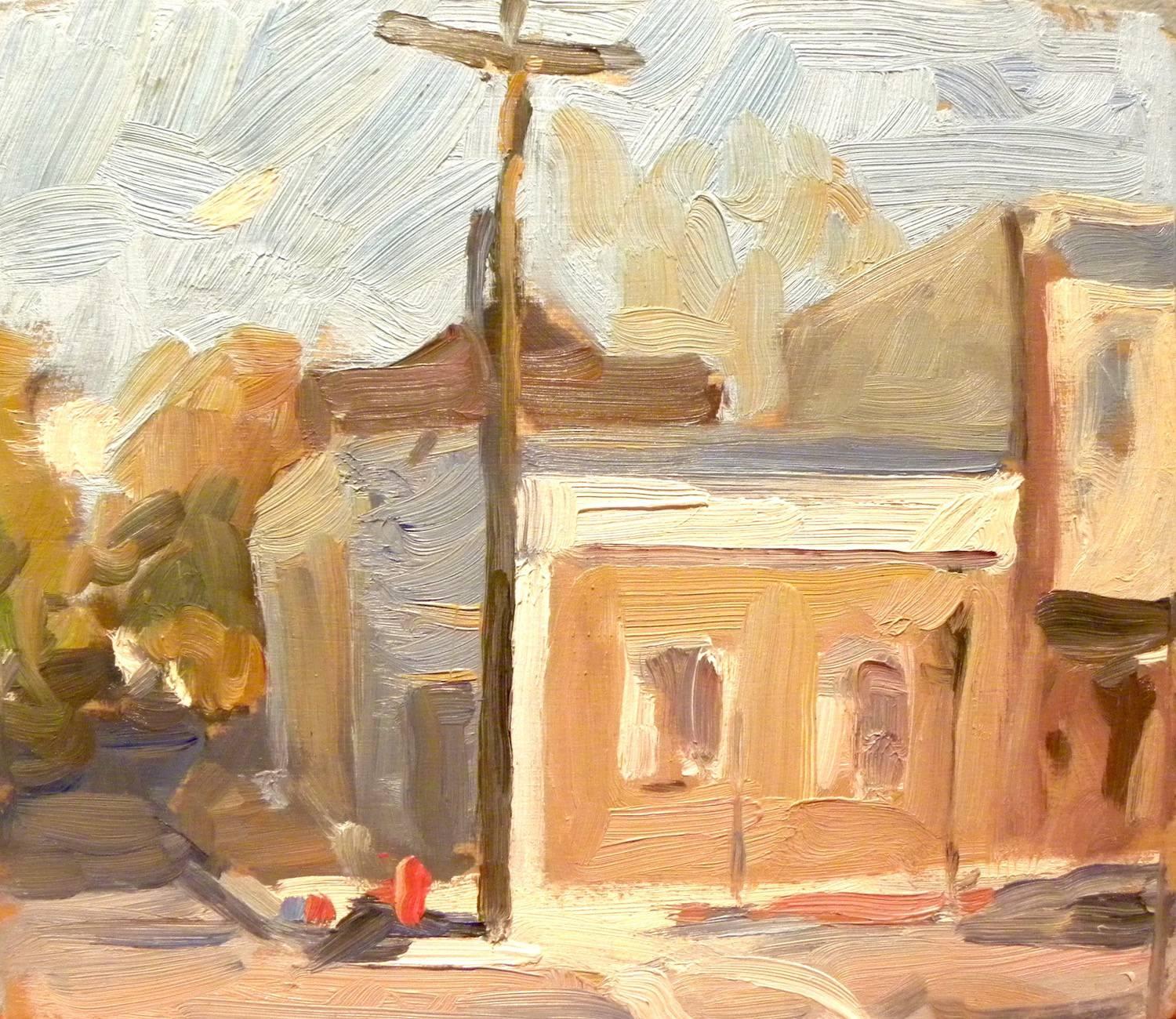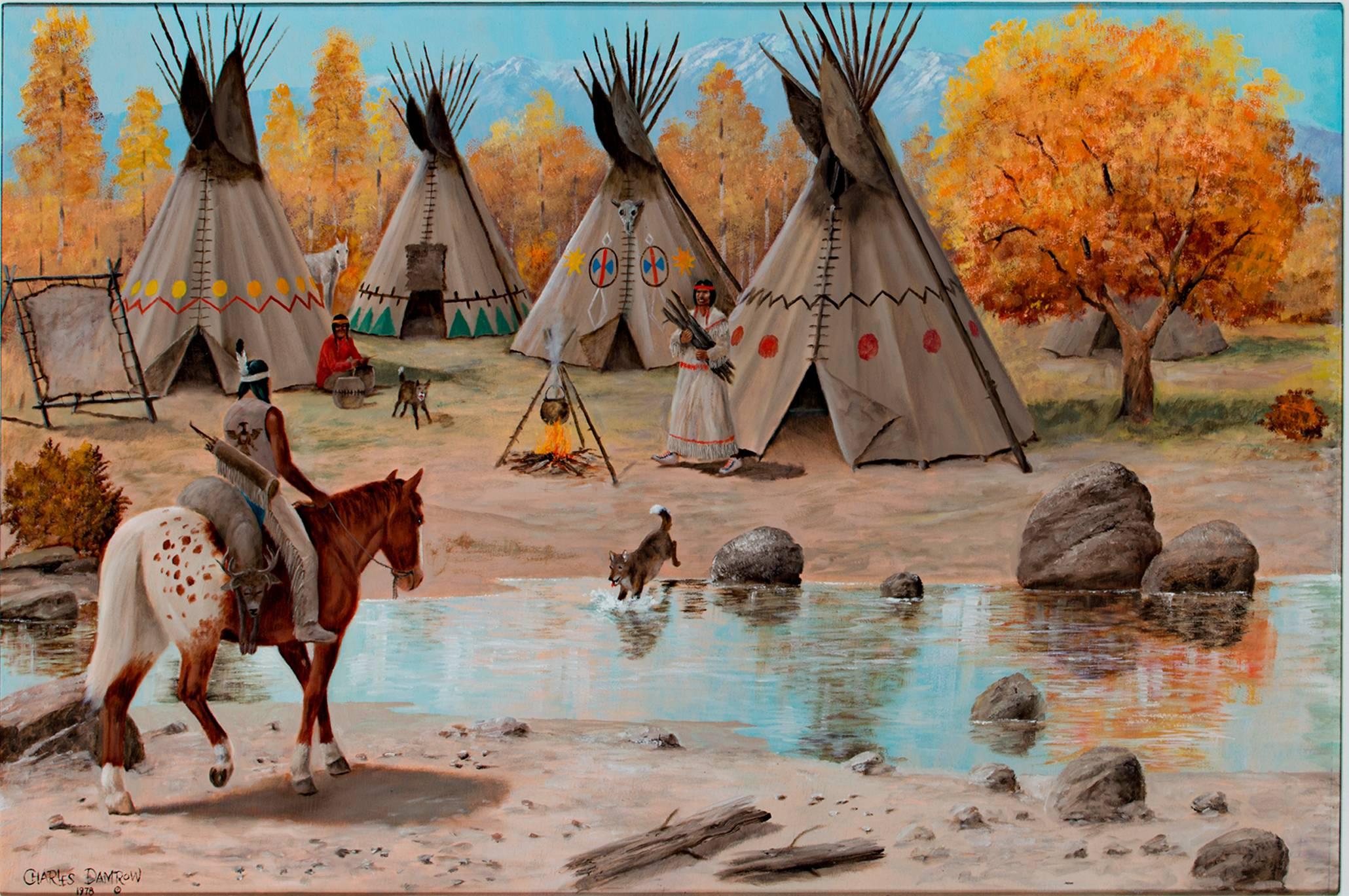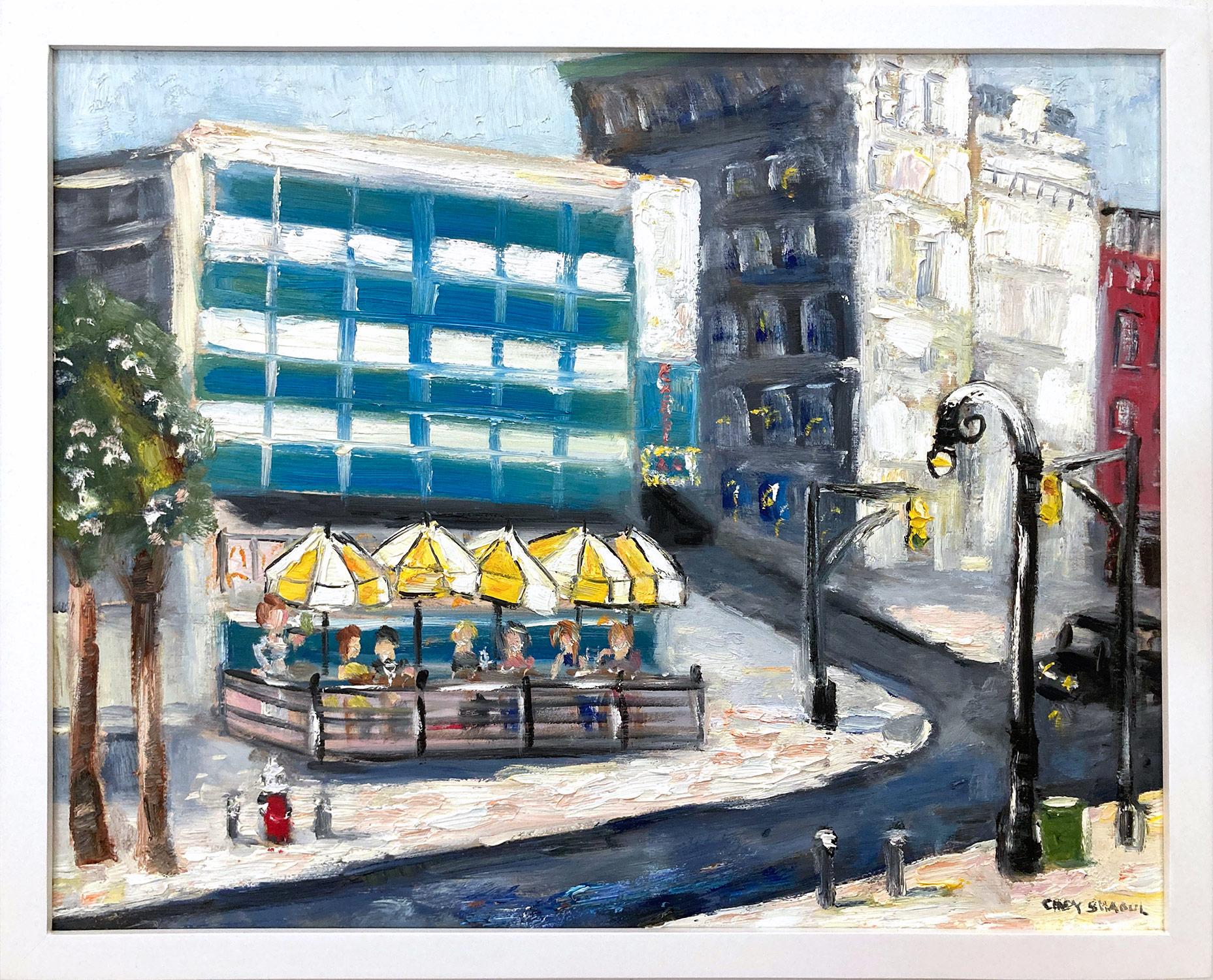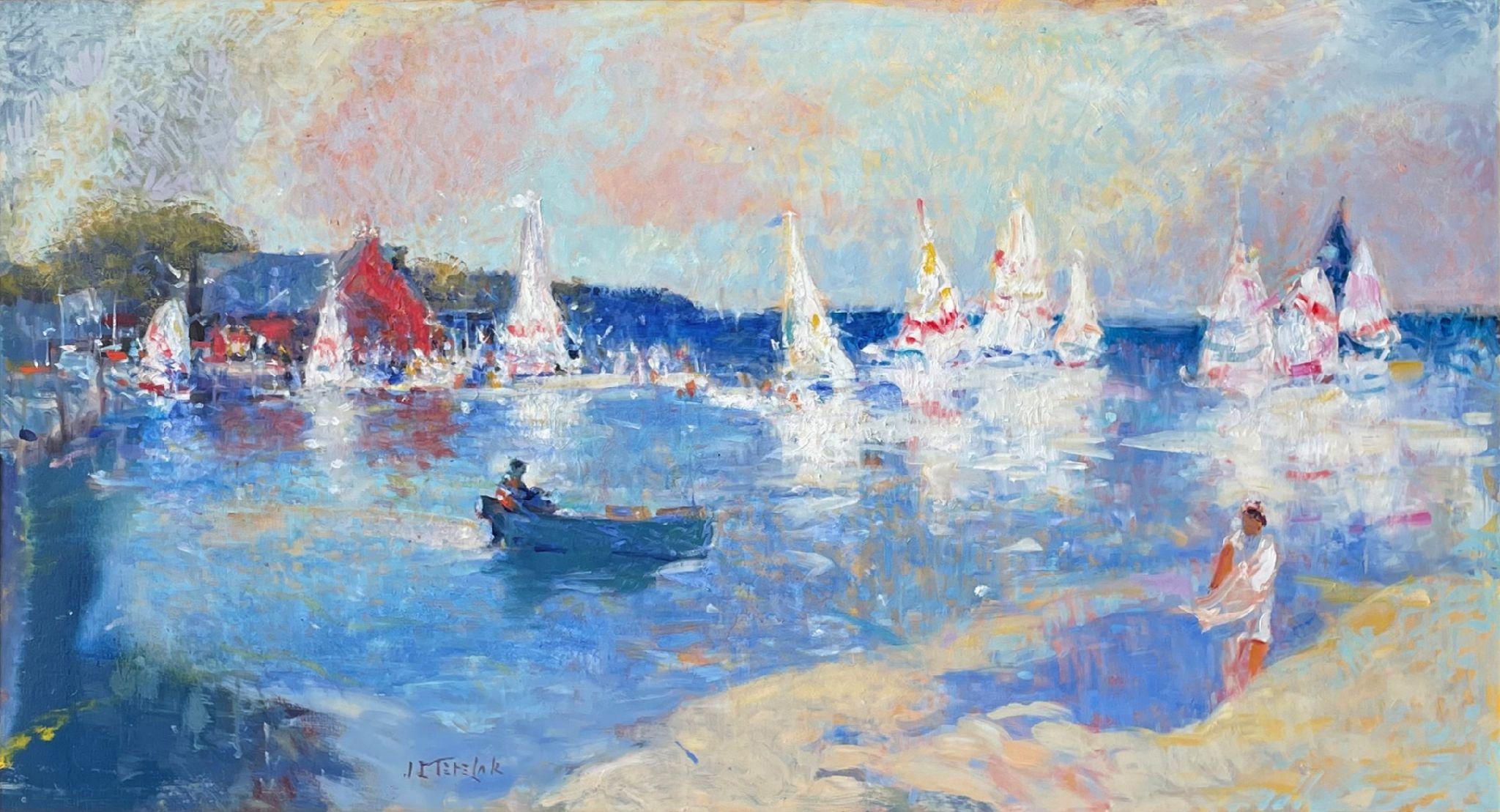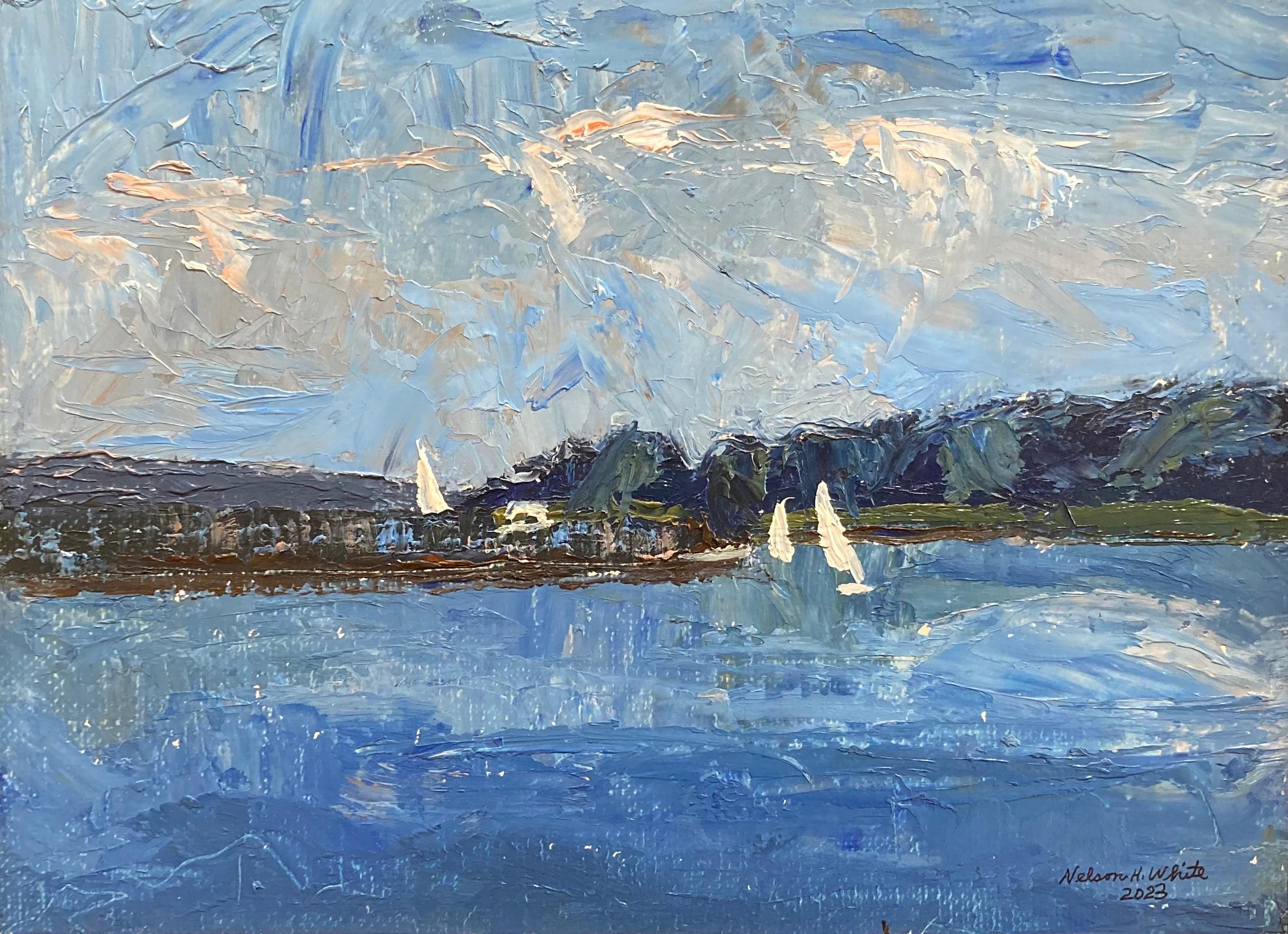Items Similar to "Summer Landscape, " Joseph DeCamp, Boston Ten American Impressionists
Want more images or videos?
Request additional images or videos from the seller
1 of 10
Joseph Rodefer DeCamp"Summer Landscape, " Joseph DeCamp, Boston Ten American Impressionists
About the Item
Joseph Rodefer DeCamp (1858 - 1923)
Summer Landscape
Oil on board
11 x 15 inches
Signed lower right
Born in Cincinnati, Ohio on November 5, 1858, Joseph DeCamp began his artistic career in his teens and remained active throughout his life. Although he initially painted landscapes, Decamp became a renowned and respected portraitist. He was famous for his images of men of high society and women within domestic interiors.
Decamp began his artistic training in 1873 when he enrolled in the McMicken School of Art and Design in Cincinnati. The head of the school, Thomas Satterwhite Noble, was a European-trained painter whose "insistence on rigorous draftsmanship, true to the academic manner in which he had been trained, exerted a lasting influence on DeCamp." DeCamp studied under Noble for five years, but was also a student of Frank Duveneck at the Ohio Mechanics Institute. He adopted Duveneck's bold, realistic style and many of his paintings executed throughout the 1870s and 1880s reflect this influence.
Like most American artists of his generation, DeCamp went abroad to study. In 1878, following in the footsteps of Duveneck and other Midwesterners, he traveled to Munich to attend the Royal Bavarian Academy. Soon after his arrival, however, he gravitated away from the academy and towards Duveneck and eventually followed his mentor to Florence and Venice. During these years, DeCamp focused on landscape and portraiture as his primary subjects. These themes would continue to occupy the artist when he returned to America in 1883.
When DeCamp arrived back in the United States in 1883, he first settled in Cincinnati, but soon moved to Cleveland to teach at what is now Case Western Reserve University. He then relocated once more to the Boston area, where he would remain for most of his life. DeCamp began teaching at Wellesley Female Academy and, in the fall of 1885, began as an instructor at the School of Drawing and Painting at the Museum of Fine Arts in Boston. He quickly established himself as one of the leading figures in the Boston art community and became a founding member of The Ten American Painters, formulated in 1897. This group included Childe Hassam, John Henry Twachtman, Julian Alden Weir, Frank Benson, Thomas Dewing, Willard Metcalf, Robert Reid, Edward Simmons, Edmund Tarbell, and William Merritt Chase. These artists were dedicated to experimentation with various styles, particularly impressionism. They also wanted more opportunity for exhibitions outside the established venues. Many, including DeCamp, had joined the Society of American Artists (SAA) when this group broke from the conservative National Academy of Design in 1877. However, The Ten American Painters felt that the SAA had itself become too restrictive. Banding together, The Ten exhibited their works as a group between 1898 and 1919. Unfortunately, many of his works were destroyed in fires at both his Boston and Maine studios.
Like most painters of his time, DeCamp usually left the bustle of the urban environment during the summer months and sketched and painted outdoors. According to DeCamp biographer Laurene Buckley, the artist "returned to landscape as a subject, especially in 1886, after he had spent the first of many summers at Annisquam on the Massachusetts coast, near Gloucester." Painters such as Hugh Bolton Jones, William Lamb Picknell, and others who had worked at the Pont-Aven art colony in Brittany frequented the thriving art community that developed in Annisquam. Many of these artists, including DeCamp, worked en plein air. This technique of sketching outdoors was wholeheartedly endorsed by William Morris Hunt, the leading Boston landscapist of the day.
While DeCamp painted and exhibited landscapes, he is best known for his portraits and for his scenes of women at leisure. His paintings of women in the first decade of twentieth century exhibit the influence of Jan Vermeer. His last work The Blue Mandarin Coat (The Blue Kimono), 1922 displayed the vogue for Japanese textiles and porcelain (japonisme) at the turn of the century in Boston. When DeCamp died on February 11, 1923 a memorial wreath was placed beneath the work, which was then in the annual show at the Pennsylvania Academy of Fine Arts.
- Creator:Joseph Rodefer DeCamp (1858-1923, American)
- Dimensions:Height: 19 in (48.26 cm)Width: 23 in (58.42 cm)
- Medium:
- Movement & Style:
- Period:
- Condition:Cradled panel.
- Gallery Location:New York, NY
- Reference Number:1stDibs: LU184129905502
About the Seller
5.0
Platinum Seller
These expertly vetted sellers are 1stDibs' most experienced sellers and are rated highest by our customers.
Established in 2021
1stDibs seller since 2022
63 sales on 1stDibs
Typical response time: <1 hour
- ShippingRetrieving quote...Ships From: New York, NY
- Return PolicyA return for this item may be initiated within 3 days of delivery.
More From This SellerView All
- "Great Kills, Staten Island" Dry Docks in Winter, Snowy Impressionist LandscapeLocated in New York, NYWilliam Jean Beauley Great Kills, circa 1917 Signed lower right Oil on panel 40 x 50 inches Housed in its original Newcomb-Macklin gilt frame Pro...Category
1910s American Impressionist Landscape Paintings
MaterialsWood Panel, Oil
- "MacMahan's Maine, " Howard Everett Giles, Figurative Landscape, ImpressionismLocated in New York, NYHoward Everett Giles (1876 - 1955) MacMahan's Maine Oil on canvas backed with board 30 x 30 inches Signed lower right Provenance: Art Institute of Chicago Christie's New York, December 8, 2011, Lot 2 Howard Giles spent most of his career in New York City, where he was an educator, magazine illustrator, and painter who espoused the theory of Dynamic Symmetry. He was born in Brooklyn, and as a young man worked in a New York railroad office. Financial support of a family friend allowed him to study at the Art Students League with H. Siddons Mowbray. In early 1910, he became an illustrator for Scribner's Magazine, and in 1912, on sketching assignment for Scribner's went to England. During World War I, he did illustration for Harper's Monthly Magazine, and many of his images were 'roaring twenties' genre and figure paintings. In 1912, he began teaching life classes at the New York School of Fine and Applied Arts (later Parsons School of Design), and remained there until the late 1920s. During that time, he was also a part-time instructor at the Childs-Walker School in Boston, and accepted numerous invitations to lecture including at Carnegie Institute in Pittsburgh, Pennsylvania Academy of the Fine Arts, Detroit Institute of Arts and Wellesley College. His initial painting style was Impressionism, but he grew increasingly interested in other scientific, aesthetic theories. He worked with Jay Hambridge from 1916 to 1919, applying Hambridge's theory of Dynamic Symmetry to his painting and his lecture topics. From 1922 to 1926, Giles also worked with and was influenced in his own painting by colorist theorist Denman Ross, who espoused a limited and related color palette. For many of his paintings, Giles used watercolor although he also painted in oil and pastels. During the last years before his retirement when he moved to Woodstock...Category
Early 20th Century American Impressionist Landscape Paintings
MaterialsPanel, Oil
- "Autumn Landscape, " Theodore Wendel, American Impressionist, Giverny, FranceBy Theodore WendelLocated in New York, NYTheodore M. Wendel (1859 - 1932) Autumn Landscape Oil on canvas laid down on panel 10 1/2 x 16 inches Signed lower right Theodore Wendel is one of the most respected American impressionists and major museums and collectors are eager to purchase exquisitely rendered works like "View from the Artist's Farmhouse, Ipswich, MA" that display Wendel's finest period of impressionism. He is considered the "most French" of American painters along with Theodore Robinson and Childe Hassam. Who Was Who in American Art states, "He was one of the most successful Impressionist landscape painters of Boston - and America…He was one of the few Americans whose works Monet chose to praise….[he was] one of the most important American Impressionists." American Art Analog states, "Theodore Wendel was one of the first American artists to embrace the form and technique of French impressionism….In the summer of 1886 he went to Giverny, the home of Monet, and joined an American colony of young artists, among them Louis Ritter...Category
Early 20th Century American Impressionist Landscape Paintings
MaterialsCanvas, Panel, Oil
- "On the Beach, " Nicolai Cikovsky, American Impressionism, Landscape SeascapeBy Nicolai CikovskyLocated in New York, NYNicolai S. Cikovsky (1894 - 1984) On the Beach Oil on panel 15 1/4 x 20 inches Signed lower right Provenance: ACA Galleries, New YorkCategory
Mid-20th Century American Impressionist Landscape Paintings
MaterialsPanel, Oil
- "The Hunt, " Francis Luis Mora, Sporting Art, Autumn Landscape, ImpressionismBy Francis Luis MoraLocated in New York, NYFrancis Luis Mora (1874 - 1940) The Hunt Oil on panel 12 x 16 inches Signed lower left F. (Francis) Luis Mora was born in Montevideo, Uruguay on July 27, 1874. His father, Domingo Mora (1840- 1911), was a Spanish architectural sculptor. His mother, Laura Gaillard, had two sisters who married into the extended Bacardi rum family of Santiago de Cuba, and Luis Mora was their nephew. His brother was Joseph Jacinto Jo Mora (1876-1947), who would become a noted California artist. In 1880, Domingo Mora accepted a position as Director of Design for the Perth Amboy...Category
Early 20th Century American Impressionist Landscape Paintings
MaterialsPanel, Oil
- "Parisian Nocturne, France, " Frank Edwin Scott, American ImpressionismBy Frank Edwin ScottLocated in New York, NYEdwin Frank Scott (1863 - 1929) Parisian Noctune, France Oil on woof panel 8 1/4 x 10 1/2 inches Signed lower left Born in Buffalo, New York, Edwin Frank ...Category
Late 19th Century American Impressionist Landscape Paintings
MaterialsWood Panel, Oil
You May Also Like
- Between Main Street and WashingtonBy Ben FenskeLocated in Sag Harbor, NYPainted en plein air in Sag Harbor, New York, a small sketch of the classic charming architecture. Painted from underneath the Sag Harbor Cinema, Fen...Category
Early 2000s American Impressionist Landscape Paintings
MaterialsOil, Panel
- Native American Nature Village Community Western 1970's Animals Seasons SignedBy Charles DamrowLocated in Milwaukee, WI"Teepee/Indian Village" is an original oil painting on wood panel by Charles Damrow. The artist signed and dated the piece in the lower left. This paint...Category
1970s American Impressionist Landscape Paintings
MaterialsOil, Wood Panel
- "Coffee Shop" Impressionistic Oil Painting of Memorable Union Square RestaurantBy Cindy ShaoulLocated in New York, NY"With shades of Pierre Bonnard’s Parisian street vistas and Edward Hopper’s New York shopfronts, American impressionist Cindy Shaoul’s oil paintings depict the much-loved locales and...Category
2010s American Impressionist Landscape Paintings
MaterialsOil, Wood Panel
- Long Beach, Sag Harbor 08.05.2023 - American Impressionist Plein Air PaintingBy Nelson H. WhiteLocated in Sag Harbor, NYA 2023 painting from the plein air painter, and American Impressionist, Nelson Holbrook White. White depicts one of his iconic red umbrellas on a beach in Long Island, NY. Framed Dimensions: 13.5 x 17.75 inches Artist Bio: Nelson H. White was born in New London, Connecticut in 1932. White has been surrounded by art and artists from the time he was born. He received his earliest art instruction from his grandfather, Henry Cooke White (1861-1952) and his father Nelson Cooke White (1900-1989), both important American artists. The family lived in Waterford, Connecticut and the elder White had been an early member of the art colony in Old Lyme, Connecticut. Known for his paintings of the Connecticut landscape and shoreline, Henry Cooke White became a teacher to his son, Nelson Cooke White. Living with his parents at the Florence Griswold house in Old Lyme, he met some of the most important and influential artists of the day, Childe Hassam, Will Howe Foote and Harry Hoffman. Later, Nelson White's father began to take his family to summer on Shelter Island and became friendly with many of the artists of the Peconic colony...Category
2010s American Impressionist Landscape Paintings
MaterialsPanel, Wood Panel, Oil
- Race DayBy John TerelakLocated in Greenwich, CTAmerican, b. 1942 John Charles Terelak is recognized as one of America's finest living impressionists. Born in Boston, Massachusetts, he received formal art instruction at the Vespe...Category
2010s American Impressionist Landscape Paintings
MaterialsOil, Panel
- "Dering Harbor, Shelter Island 6.19.2023" American Impressionist landscape, NYBy Nelson WhiteLocated in Sag Harbor, NYFramed Dimensions: 17 x 20 inches Artist Bio Nelson H. White was born in New London, Connecticut in 1932. White has been surrounded by art and artists from the time he was born. He received his earliest art instruction from his grandfather, Henry Cooke White (1861-1952) and his father Nelson Cooke White (1900-1989), both important American artists. The family lived in Waterford, Connecticut and the elder White had been an early member of the art colony in Old Lyme, Connecticut. Known for his paintings of the Connecticut landscape and shoreline, Henry Cooke White became a teacher to his son, Nelson Cooke White. Living with his parents at the Florence Griswold house in Old Lyme, he met some of the most important and influential artists of the day, Childe Hassam, Will Howe Foote and Harry Hoffman. Later, Nelson White's father began to take his family to summer on Shelter Island and became friendly with many of the artists of the Peconic colony...Category
21st Century and Contemporary American Impressionist Landscape Paintings
MaterialsOil, Panel, Wood Panel
Recently Viewed
View AllMore Ways To Browse
Antique Boston
Ten Works By Ten Painters
American Leisure
Japanese Landscape Antique
Robert Frank The Americans
19th Century Western Paintings
Bavarian Art
Antique American 1870s
Japanese Painting Kimono
Thomas Jones
Female Impressionist 19th Century
Bavarian Painted
Returning From The Hunt
Edward Morris
John Reid
Antique Japanese Porcelain Figures
Pont Aven
19th Century Western Oil Paintings
